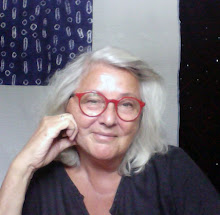 John Mawurndjul is from Maningrida, in North Australia. He was born in 1952 and has been intensely prolific for thirty years.
John Mawurndjul is from Maningrida, in North Australia. He was born in 1952 and has been intensely prolific for thirty years. Mardayin at Mankarrard 2004 Ochres on bark 204 x 74 cm
 Mardayin Ceremony 1999 ochres on bark 153 x 88 cm
Mardayin Ceremony 1999 ochres on bark 153 x 88 cmI've gathered these images and information from a book just published in 2008 about the collection of Colin and Elizabeth Laverty, Beyond Sacred, Recent Painting from Australia's remote Aboriginal communities. The specific text about John Mawurndjul is by Apolline Kohen.
 Mardayin at Makkamukka 1998ochres on bark 158 x 78 cm
Mardayin at Makkamukka 1998ochres on bark 158 x 78 cmIn 1989, his work was included in the landmark exhibition "Les magiciens de la terre" at the Centre Georgess Pompidou in Paris, France. During the 90's his work became abstract images about the rarely performed Mardayin ceremony. This is a ceremony about clan identity and about mortuary rites.
His paintings are on bark. I only have seen them in reproduction, but I imagine them to be wonderfuly textural and earthy in reality.
 Mardayin at Kakodbebuldi 1998 orchres on bark 154 x 64 cm
Mardayin at Kakodbebuldi 1998 orchres on bark 154 x 64 cm His work since 2000 are abstract representations of places in his clan estate. I am inspired by the way John Mawurndjul balances circles within intense backgrounds. His use of the cross hatching infil (called rarrk) in the backgrounds is innovative and has been a huge influence on other Kuninku artists.
 Mardayin at Milmilngkan 2003 etching on paper 60 x 35 cm
Mardayin at Milmilngkan 2003 etching on paper 60 x 35 cmIn 2005, the artist was given a retrospective of his work at the Musee Jean Tinguely in Basel, Switzerland that then travelled to Germany.


















